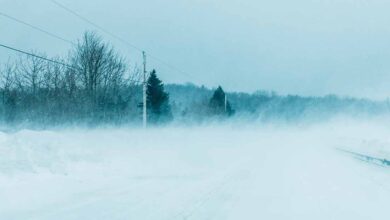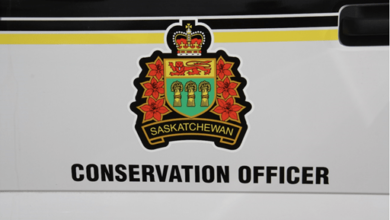
“The Decision to Close Roads Is Made When Two or More Hazardous Conditions Exist”
By Jenny Hagan
As winter drags on, the weather continues to bring challenges for our emergency crews.
Recently, EMS directors Glen Perchie (South) and Krista Remeshylo (Central) spoke on how they “really worry about their team” during winter storms. Both former paramedics have an intimate knowledge of the challenges their team is facing out there. “It’s scary out there. Visibility, temperature, and slippery roads, those three things are probably the scariest” Winter is one of the worst times for EMS as far as the additional factors to consider and think about.
When travelling during these storms when travel advisories are in place Krista states to “expect delays” not just in your travel but in response time for emergency services to reach you if something happens. EMS personnel will take calculated risks to get to patients in need, but in extreme cases EMS may not be able to respond until conditions improve. She encourages those in rural areas to make a plan in case emergency crews cannot reach you especially if you have a known medical condition. Be proactive in your approach. Plan how neighbours can help you or stay in town with family and friends when a storm is coming so you don’t have to worry about blown in roads. Glen states “think hard if you decide to travel if you really, really need to. Calling 911 may not get what you want right away. We will get there as soon as we can but when we can, might be hours from now. You can’t force a vehicle through snow that won’t go.
They have a few key safety points. If your ever stranded on the road get as far over as you can and stay as visible as possible. Stay with your vehicle and don’t travel on foot. Krista also half jokes “don’t play games on your cell phone while you wait” to be helped. It kills your battery and could cause you to have no means of communication to be rescued. We joke about these things, but they are important points to keep you safe if you run into problems.
Saskatchewan Department of Highways Doug Wakabayashi states that the decision to close roads is made when two or more hazardous conditions exist. One of which is zero visibility. “When visibility drops below 200 meters, we pull our equipment from the roads” Done for the safety of the crew and motorists. This could mean emergency services won’t be able to reach you because highways are not being maintained. They highly recommend that when it’s posted travel not recommended or closed that people just stay home. Doug states that every winter there is a number of collisions with snowplows “We need the public to be aware and to slow down when they see the flashing lights” Visibility is reduced from the plow kicking up a cloud of snow and you may not be able to see oncoming traffic. Plows will pull over every 10-15 km to allow traffic by. Just be patient.
Doug also states they see a lot of stopped or abandoned vehicles in driving lanes in these severe winter storms. “It really increases the time it takes to get roads back into driving condition” He advises the public to pull as far right as they possibly can in these situations so stranded motorists can be reached quickly after conditions improve.
Cody Phinney from the Kindersley Fire Department shared that due to the physically demanding nature of firefighting, dehydration is still a worry year-round. There is also an increased risk of hypothermia, and that their bunker gear does a great job of keeping them warm but can only do so much. “We also get wet while operating hose lines, and everyone knows that is never a good idea in freezing temperatures.” In addition to risks to members attending emergency situations he also said that an often-overlooked aspect of winter emergencies is the people involved in the situation. “For example, a person involved in an accident on the highway can be left without shelter until we arrive on scene.”
They also shared that they urge the public to always be prepared for an emergency. A person can never know when or what type of emergency can arise, but being properly prepared can make a large difference in the outcome of a situation. “Keeping an emergency kit in a vehicle with food, drinks and extra warm clothing is extremely important for winter traveling.”
So before you head out on the roads during a winter storm, take a moment to consider if the risk, to everyone involved, is worth it.









































